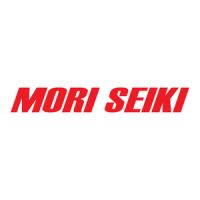P-12 FOR SAFE MACHINE OPERATION PARA UNA UTILIZACIÓN SEGURA DE LA MÁQUINA
ATENCION
<Safety Precautions>
1. When machining long workpieces, always
clamp the free end of the workpiece
securely with the tailstock or a steady rest (if
installed).
[Workpiece bent or shaken during spindle
rotation, ejection outside of the machine]
2. Before clamping a workpiece in the chuck,
check using a pressure gage that the cor-
rect hydraulic or air pressure is supplied to
the cylinder that actuates chuck operation.
[Workpiece ejection]
3. If a gap exists between the workpiece rear
surface and the chuck locator face or the
jaw face on which the workpiece is to be
seated, the workpiece rotation centerline is
tilted in relation to the chuck rotation cen-
terline, or if the workpiece is cast or forged,
carry out test cutting at a low spindle speed
to ensure safety.
[Cutting force exceeds workpiece clamping
capacity of chuck, causing workpiece ejec-
tion]
4. When a workpiece is eccentric, not round or
the center of gravity of the workpiece is not
at the center of the rotation, balance using a
balancer with full consideration given to
machining conditions such as the spindle
speed.
[Workpiece ejection]
5. Do not rotate the spindle without a work-
piece when using a balancer.
[Spindle bearing wear, component seizure]
6. When using a manually tightened chuck or
fixture, always remove the clamp handle or
tightening tool from the chuck or fixture
after tightening.
[Clamp handle, tightening tool ejection]
<Precauciones de seguridad>
1. Cuando mecanice piezas grandes, sujete siempre
el extremo libre de la pieza con el contrapunto o
con un soporte fijo (si está instalado).
[Pieza doblada o golpeada durante la rotación del
husillo, eyección fuera de la máquina]
2. Antes de sujetar una pieza en el plato, compruebe
mediante un indicador de presión que se suministra
una presión hidráulica o de aire adecuada al cilindro
que realiza la operación del plato.
[Eyección de pieza]
3. En caso de que exista un espacio entre la superficie
trasera de la pieza y la cara del localizador del plato
o la cara de la mordaza en la que se colocará la
pieza, la línea central de rotación de la pieza se
inclinará en relación con la línea central de rotación
del plato, o, si la pieza está fundida o forjada, realice
un corte de prueba con una velocidad del husillo
baja para garantizar la seguridad.
[La fuerza de corte supera la capacidad de sujeción
de la pieza por el plato, causando la eyección de la
pieza]
4. Cuando una pieza es excéntrica, no es redonda o el
centro de gravedad de la pieza no se encuentra en el
centro de rotación, equilíbrela utilizando un
equilibrador y reflexionando atentamente a las
condiciones de mecanizado como la velocidad del
husillo.
[Eyección de pieza]
5. No gire el husillo sin una pieza cuando utilice un
equilibrador.
[Desgaste de rodamientos del husillo, daños a
componentes]
6. Cuando utilice un plato o utillaje manualmente,
retire siempre la palanca de la pieza o la herramienta
de apriete del plato o utillaje tras el apriete.
[Eyección de herramienta de apriete, palanca de
sujeción]
PRECAUCION
1. When chucking or supporting a workpiece,
take the rigidity of the workpiece into
account when determining the chucking or
supporting method and chucking pressure
or tailstock thrust (if installed).
[Impaired machine accuracy]
1. Cuando agarre o apoye una pieza, tenga en cuenta
la rigidez de la pieza cuando determine el método de
sujeción o de apoyo y la presión de agarre o el
empuje del contrapunto (si está instalado).
[Afectación de la precisión del mecanizado]
2. Do not subject the chuck jaws or workpiece
to shock.
[Adversely affecting chucking accuracy,
functions, and service life]
2. No someta a golpes las mordazas del plato o la
pieza.
[Esto afectaría negativamente la precisión del
agarre, sus funciones y su vida útil]
3. When leaving the machine with the power
OFF for an extended period, always remove
the workpiece from the clamping device.
[Dropped workpiece/Chuck and tailstock
clamping mechanism service life adversely
affected]
3. Cuando deje la máquina durante un período
prolongado de tiempo sin suministro eléctrico, retire
siempre la pieza del dispositivo de sujeción.
[Caída de pieza/Vida útil del plato y del mecanismo
de sujeción del contrapunto afectados
negativamente]
4. When clamping or unclamping the chuck,
take care to ensure hands or fingers do not
become caught in the chuck or chuck jaws.
[Injury]
4. Cuando sujete o suelte el plato, tenga cuidado de
que no se le queden las manos o dedos atrapados
en el plato o mordazas del plato.
[Lesión]

